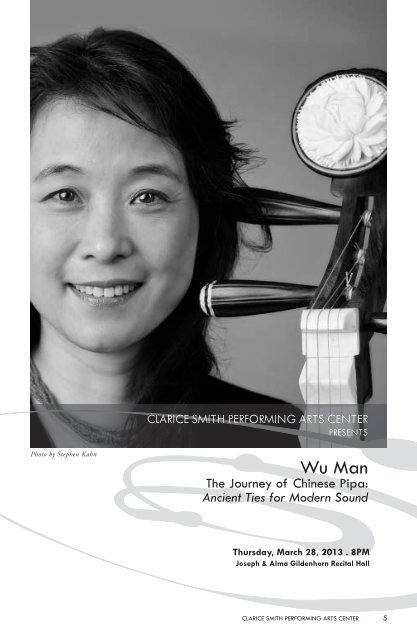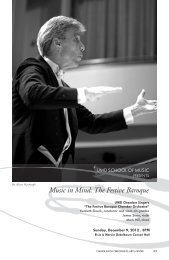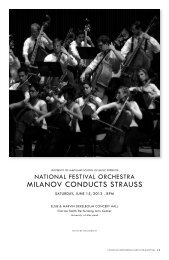Download Now (PDF) - Clarice Smith Performing Arts Center
Download Now (PDF) - Clarice Smith Performing Arts Center
Download Now (PDF) - Clarice Smith Performing Arts Center
Create successful ePaper yourself
Turn your PDF publications into a flip-book with our unique Google optimized e-Paper software.
Photo by Stephen Kahn<br />
CLARICE SMITH PERFORMING ARTS CENTER<br />
PRESENTS<br />
Wu Man<br />
The Journey of Chinese Pipa:<br />
Ancient Ties for Modern Sound<br />
Thursday, March 28, 2013 . 8PM<br />
Joseph & Alma Gildenhorn Recital Hall<br />
CLARICE SMITH PERFORMING ARTS CENTER 5
PROGRAM<br />
Wu Man<br />
The Journey of Chinese Pipa: Ancient Ties for Modern Sound<br />
Xi Yang Xiao Gu (Flute and Drum Music at Sunset)<br />
Classical (Civil)<br />
The Sound of Bells and Drums from a Distant Temple along the River<br />
Moon on the Eastern Mountain<br />
Breeze over the Quiet Water<br />
Shadows of Flowers<br />
Clouds and Water Far Away Become as One<br />
A Fishman’s Song in the Evening<br />
Waves Lapping at the Shore<br />
The Returning Boat<br />
Shi Mian Mai Fu (Ambush Laid on Ten Sides)<br />
Classical (Martial)<br />
Xu Lai (Meditation)<br />
Liu Tianhua<br />
Kazakh küi<br />
Traditional<br />
arr. Wu Man<br />
Dance of the Yi People<br />
Wang Huiran (b.1935)<br />
San Liu (Three Six)<br />
Traditional<br />
Night Thoughts<br />
Wu Man<br />
Leaves Flying in Autumn<br />
Wu Man<br />
Approximately 90 minutes with no intermission.<br />
This performance is included in Diversity Through Music, an event series sponsored by the<br />
UMD Office of Diversity Education and Compliance and the Nyumburu Cultural <strong>Center</strong> through<br />
a grant from the Office of Diversity and Inclusion with the cooperation of the <strong>Clarice</strong> <strong>Smith</strong> <strong>Center</strong>.<br />
To view a full schedule of events, visit the Nyumburu Cultural <strong>Center</strong>’s website.<br />
Wu Man most recently appeared at the <strong>Center</strong> in A Chinese Home with<br />
Kronos Quartet (2009-2010).<br />
claricesmithcenter.umd.edu | 301.405.ARTS (2787)<br />
PROGRAM NOTES<br />
Musical America’s 2013 Instrumentalist of the Year and GRAMMY Award-nominated<br />
artist Wu Man is recognized as both a virtuoso and ambassador of the pipa, or Chinese<br />
lute, which has a history of more than two thousand years. Her creativity and curiosity has<br />
led to collaborations with some of the world’s leading contemporary composers such as<br />
Tan Dun, Philip Glass, the late Lou Harrison, Terry Riley, Bright Sheng, Chen Yi and<br />
many others. She also frequently performs as a member of the Silk Road Ensemble with<br />
cellist Yo-Yo Ma, and with the Kronos Quartet.<br />
Wu Man has spent the majority of her career tracing the history of her instrument<br />
throughout her native China and into Central Asia. Gramophone magazine stated, “A onewoman<br />
force of nature, she is a key figure not only for bringing Chinese traditional music<br />
to new audiences, but in becoming a muse for all manner of contemporary composers.”<br />
While documenting hundreds of journeys and adventures to little-known regions of<br />
Asia, Wu Man unearthed ancient musical traditions that have influenced both the pipa’s<br />
repertoire and Wu Man’s own technique. In this program including selections from her<br />
recordings Wu Man and Friends, Immeasurable Light and her most recent album<br />
Borderlands, Wu Man takes the audience on an illuminating and deeply personal journey<br />
of how the pipa’s story has shaped her own.<br />
Xi Yang Xiao Gu (Flute and Drum Music at Sunset)<br />
Classical (Civil)<br />
A hand-written score for this pipa piece first appeared in 1875 as a piece with seven<br />
untitled sections. It was later discovered with subtitles among Chen Zijing’s hand-written<br />
collection of pipa music in 1898. The present score, having eight sections with subtitles, is<br />
taken from Li Fangyuan’s New Collections, 1895. This composition is of the “civil” style<br />
of pipa music.<br />
Shi Mian Mai Fu (Ambush Laid on Ten Sides)<br />
Classical (Martial)<br />
Perhaps the best known of all traditional pipa works, this is a grand opus of the “martial”<br />
school of pipa music. A hand-written score for pipa solo first appeared in 1875. Structured<br />
in traditional story-telling form, “Shi Mian Mai Fu” portrays the epic battle between the<br />
kingdoms of Han (Liu Bang) and the warlord of Chu (Xiang Yu) in 202 BC. The Han<br />
army ambushed the Chu army on ten sides and finally defeated the powerful Chu (Xiang<br />
Yu committed suicide), leading to the establishment of the Han Dynasty. The music<br />
describes how the armies set up camp, effected the ambush and fought fiercely. In it can<br />
be heard the war drums, booming guns, soldiers and horses, and the shouting of soldiers<br />
at the massacre. The victors return to camp in triumph at the end of a stirring battle.<br />
Variations on a theme make use of tonal colors and timbres created by various fingering<br />
techniques to evoke a range of moods, heroism, stoicism, despair and tragedy.<br />
Xu Lai (Meditation) (1929)<br />
Liu Tianhua<br />
Liu Tianhua was a 20th-century intellectual, composer and musician who tried to<br />
formalize and modernize the study and performance of traditional Chinese music,<br />
sometimes with ideas borrowed from the West. In this work, the music conjures up the<br />
image of a person seated by a window, in the emptiness and stillness of the night,<br />
lost in meditation.<br />
WU MAN The Journey of Chinese Pipa: Ancient Ties for Modern Sound 7
PROGRAM NOTES<br />
Kazakh küi<br />
Traditional, arr. Wu Man<br />
Wu Man made this arrangement for pipa of a Kazakh folk tune that she heard performed<br />
on the dombÿra, the two-stringed plucked lute that is widely regarded as a cultural symbol<br />
of Kazakhs. Kazakhstan shares a long border with western China, and nomadic Kazakhs<br />
have long represented an ethnic minority in China’s Xinjiang-Uyghur Autonomous<br />
Region. In Xinjiang, Kazakhs speak their own language and maintain their own musical<br />
traditions. The pipa is believed to have entered China long ago through contact between<br />
Chinese civilization and the peoples whom ancient Chinese sources described as “northern<br />
barbarians,” which is to say, nomads. By performing this virtuosic nomadic melody on the<br />
pipa, Wu Man brings her instrument full circle, back to its Central Asian origins.<br />
Dance of the Yi People (1960)<br />
Wang Huiran (b.1935)<br />
This is one of the signature pieces in the repertoire of Wu Man. Wang arranged this<br />
wonderful piece in 1960 based on folk tunes of the Yi minority people, who live in<br />
southwestern China. However, the piece did not gain popularity during the Cultural<br />
Revolution (1966 to 1976) because the music evokes intoxicating nights on a<br />
mountainside and the joyous gathering of young people with lively dancing, and has<br />
nothing to do with the “Red Revolution,” which was necessary to be approved by censors<br />
at the time. Wu Man selected this piece for her audition to enter the Conservatory in<br />
Beijing in 1978 and won first place. Her performance of the piece was recorded and<br />
broadcast throughout the nation. Since then, it has become one of the most popular pieces<br />
in the pipa repertoire. This is the first pipa composition to incorporate the Western A-B-A<br />
structure, adopt Western chords and guitar techniques, and display virtuoso pipa<br />
techniques such as tremolos, strumming, sliding notes and harmonics.<br />
San Liu (Three Six)<br />
Traditional<br />
This is a popular folk tune from the Shanghai area, often played with a small ensemble<br />
at a tea house.<br />
Night Thoughts (2005)<br />
Wu Man<br />
The piece was inspired by a 9th-century Buddhist pipa tune and represented for Wu Man<br />
a chance to rediscover the pipa’s native, regional language. The piece is particularly drawn<br />
to its ancient-tune scale, which is very different from today’s mostly pentatonic pipa music,<br />
and to the peaceful, meditative sound of the pipa in the low register.<br />
Leaves Flying in Autumn (2000)<br />
Wu Man<br />
Wu Man composed this improvisational collage a few years ago with inspiration from<br />
the classical martial style of pipa works and a nod to rock ’n’ roll.<br />
ABOUT THE ARTIST<br />
Recognized as the world’s premier pipa virtuoso and leading ambassador of Chinese<br />
music, GRAMMY Award-nominated musician Wu Man has carved out a career as<br />
a composer, soloist and educator giving her lute-like instrument — which has a history<br />
of more than 2,000 years in China — a new role in both traditional and contemporary<br />
music. Through numerous trips to her native China, Wu Man has premiered hundreds<br />
of new works for the pipa, while spearheading multimedia projects to both preserve and<br />
create awareness of China’s ancient musical traditions. Collaborations across artistic<br />
disciplines have allowed Wu Man to reach wider audiences as she works to break through<br />
cultural and musical borders. On December 6, 2012 Wu Man was named Musical<br />
America’s 2013 Instrumentalist of the Year, the first traditional musician ever to receive<br />
this prestigious award.<br />
During the 2012-13 season Wu Man will tour for solo recitals across the United<br />
States and will continue to tour with the Silk Road Ensemble. She will premiere her new<br />
composition “Blue and Green” during a nine-city United States tour with New York<br />
City’s The Knights. Wu Man will also perform at the 2013 Auckland <strong>Arts</strong> Festival in<br />
New Zealand both in a solo recital and together with the Kronos Quartet in a performance<br />
of A Chinese Home, a work commissioned by the <strong>Clarice</strong> <strong>Smith</strong> <strong>Performing</strong> <strong>Arts</strong> <strong>Center</strong>.<br />
Wu Man’s latest album Borderlands was released by <strong>Smith</strong>sonian Folkways in May 2012,<br />
and her documentary Discovering a Musical Heartland: Wu Man’s Return to China was<br />
released in September of the same year.<br />
claricesmithcenter.umd.edu | 301.405.ARTS (2787) WU MAN The Journey of Chinese Pipa: Ancient Ties for Modern Sound 9




